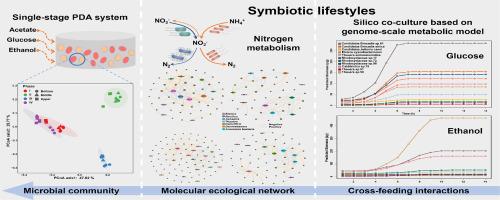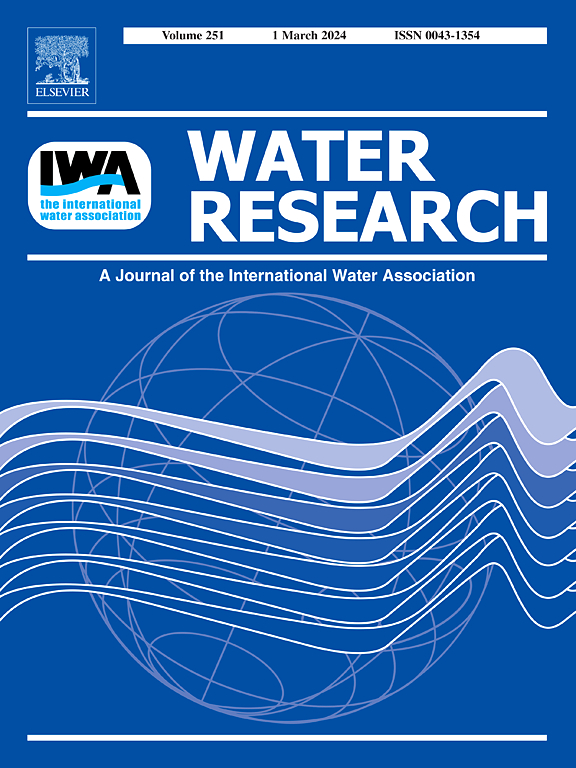Integrating network and in-silico simulation insights into the ecological interactions shaped by carbon sources in partial denitrification and anammox system
IF 11.4
1区 环境科学与生态学
Q1 ENGINEERING, ENVIRONMENTAL
引用次数: 0
Abstract
The underlying ecological mechanism of microbial communities shaped by carbon source in partial denitrification and anammox (PDA) systems remains poorly understood, despite the potential of multiple carbon sources to support the partial denitrification process. Herein, the integrated network and in-silico simulation methods were used to evaluate the considerable impact of carbon sources on the dynamics of ecological interactions. The fluctuation of carbon source (from acetate to glucose and ethanol) significantly destabilized the performance of PDA system (total nitrogen removal efficiency decreased from 96.8% to 69.1%). Glucose simultaneously altered the composition of denitrifying bacteria, resulting in a significant enrichment of the genus Elstera (from 0% to 12.7%). By contrast, genus Thauera re-dominated for partial denitrification with ethanol as carbon source. Importantly, heterotrophic bacteria (e.g., genus Calditrichia) gradually enriched by utilizing ethanol. The presence of acetate in phase IV further enhanced the competitive advantage of heterotrophic bacteria over denitrifying bacteria, thereby resulting in the deteriorated performance of the PDA system. The in-silico simulation of co-culture further revealed that the overgrowth of auxotrophic species Calditrichia utilized amounts of nutrients and limited other functional bacteria. Additionally, the whole co-occurrence network indicated that positive interactions likely improved the adaptability of anammox bacteria under the unsteady conditions. This study provides profound insights into the ecological interactions shaped by carbon sources in PDA systems and underscores the necessity of comprehensive review of the external carbon source to ensure optimal performance.


求助全文
约1分钟内获得全文
求助全文
来源期刊

Water Research
环境科学-工程:环境
CiteScore
20.80
自引率
9.40%
发文量
1307
审稿时长
38 days
期刊介绍:
Water Research, along with its open access companion journal Water Research X, serves as a platform for publishing original research papers covering various aspects of the science and technology related to the anthropogenic water cycle, water quality, and its management worldwide. The audience targeted by the journal comprises biologists, chemical engineers, chemists, civil engineers, environmental engineers, limnologists, and microbiologists. The scope of the journal include:
•Treatment processes for water and wastewaters (municipal, agricultural, industrial, and on-site treatment), including resource recovery and residuals management;
•Urban hydrology including sewer systems, stormwater management, and green infrastructure;
•Drinking water treatment and distribution;
•Potable and non-potable water reuse;
•Sanitation, public health, and risk assessment;
•Anaerobic digestion, solid and hazardous waste management, including source characterization and the effects and control of leachates and gaseous emissions;
•Contaminants (chemical, microbial, anthropogenic particles such as nanoparticles or microplastics) and related water quality sensing, monitoring, fate, and assessment;
•Anthropogenic impacts on inland, tidal, coastal and urban waters, focusing on surface and ground waters, and point and non-point sources of pollution;
•Environmental restoration, linked to surface water, groundwater and groundwater remediation;
•Analysis of the interfaces between sediments and water, and between water and atmosphere, focusing specifically on anthropogenic impacts;
•Mathematical modelling, systems analysis, machine learning, and beneficial use of big data related to the anthropogenic water cycle;
•Socio-economic, policy, and regulations studies.
 求助内容:
求助内容: 应助结果提醒方式:
应助结果提醒方式:


